Cinematic Techniques in Disney Films
Disney films have long captured the hearts of audiences with their enchanting stories and pioneering cinematic techniques. From its earliest days, Disney experimented with various methods to bring magic and emotion to the screen. In this blog post, we delve into the world of Disney’s filmmaking, exploring key cinematic techniques used throughout its lineage. We’ll cover the production process and the role of animation sheets, the artistic painting techniques that redefine visuals, the evolution of presentation styles, and how these elements contribute to the timeless happily-ever-after moments in Disney films.
Production and Sheets
The foundation of Disney’s iconic style starts with meticulous planning and a deep understanding of production dynamics. From storyboarding to character design, Disney’s emphasis on structured production is evident in how they outline each film’s visual journey. Storyboarding, in particular, serves as a blueprint for the narrative, carefully detailing each scene’s composition and flow. This technique allows directors and animators to experiment with visual storytelling, adjusting camera angles and perspectives before any actual animation begins.
Another essential component in Disney’s production process is the use of animation sheets. These sheets are crucial for character consistency and expression. Sheets contain detailed drawings of characters, each showing the minute changes needed to capture movement and emotion accurately. This process, known as “in-betweening,” ensures smooth transitions between frames and brings characters to life in a way that engages the audience completely.
Painting the Sheets
Once the groundwork of the sheets is laid, Disney artists employ exceptional painting techniques to breathe life and color into animations. The use of rich, vibrant colors helps to establish mood and setting, pulling viewers into mesmerizing fantasy worlds. The innovation of multicolor effects and shading techniques not only enhance the three-dimensional illusion but also add depth to each scene.
One of Disney’s revolutionary breakthroughs was the use of the multiplane camera, which allowed for layers to be painted individually and then filmed at varying speeds and distances from the camera. This technique introduced a sense of depth, making backgrounds more dynamic and providing the illusion of a 3D space within a 2D medium. The results were scenes that felt as though they extended beyond the boundaries of the screen, enhancing the narrative’s visual impact.
Later Presentations
As technology advanced, so did Disney’s cinematic techniques, evolving from traditional hand-drawn animations to more sophisticated methods like computer-generated imagery (CGI). This transition allowed Disney to explore new storytelling dimensions, practically eliminating previous limitations. Films like “Toy Story” and “Frozen” utilized CGI to create visceral, lifelike animations that conveyed emotions and movements with unprecedented realism.
Moreover, the incorporation of advanced sound design and musical compositions has become integral to the Disney experience. The blend of animation with intricate soundscapes and memorable scores elevates the narrative, making the films not only a visual spectacle but an auditory one as well. These enhancements solidify Disney’s reputation as a leader in cinematic innovation, ensuring that their films remain as captivating today as they were decades ago.
Happily Ever After
Disney’s ability to craft enduring tales is deeply rooted in how it combines cinematic techniques to create a harmonious narrative experience. By merging powerful storytelling with innovative animation, Disney films achieve a sense of resolution and emotional closure that resonates with audiences. The culmination of artistry, technology, and story is what delivers the timeless “happily ever after” that Disney is renowned for.
These techniques do more than just tell a story; they allow audiences to embark on a journey, feel connected to characters, and experience a broad spectrum of emotions. The magic of Disney is its ability to continuously adapt and innovate while keeping the core essence of storytelling and emotional engagement intact. As new techniques and technologies emerge, Disney remains a pioneer, constantly redefining the boundaries of animated film.
Final Thoughts
| Aspect | Details |
|---|---|
| Production and Sheets | Focus on storyboarding and animation sheets, ensuring consistency and expressive movement. |
| Painting the Sheets | Use of vibrant colors and the multiplane camera to create depth and mood. |
| Later Presentations | Transition to CGI and emphasis on sound design and composition. |
| Happily Ever After | The seamless blend of storytelling and innovative animation techniques for emotional impact. |
